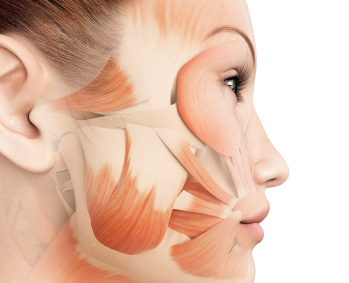
© Science Photo Library
Another treatment option is the injection of neuromodulators, including Botox. “Over the past 20 years, we’ve learned a lot about how we can use these to help with facial dysfunction, symmetry, and balance,” Dr. Byrne said. Targeted Botox injections can weaken the muscles that are pulling in a direction that isn’t in favor of relaxed facial movement. The specific injection locations will vary from patient to patient, depending on their presentation. Muscles that are frequently targeted include the platysma and the depressor anguli oris.
Explore This Issue
November 2020Botox injection can complement facial retraining. “Sometimes, it takes too much patient effort to suppress unwanted movement in the face,” Dr. Boahene said. “If you use Botox to help them out, they can put their effort into the movement they want, and then over time the brain picks up this new pattern of movement and you don’t need to keep repeating the Botox.”
Some patients return to baseline after the Botox wears off, however. Physicians can repeat the injection, but if the face once again returns to its unwanted baseline, it’s time to consider surgical options.
Surgical Options
There are a number of surgical options for improving facial function that can make a difference for patients:
Selective Myectomy. One option is to surgically target the muscles that are causing unwanted facial movement or restricting the smile. If weakening the muscles with botulinum toxin improves facial function and symmetry, this temporary result can be made permanent by cutting specific facial muscles. “You can cut some of the lower lip muscles to either release the smile or balance the lower lip. You can also cut the platysma muscle if it’s causing banding or discomfort in the neck,” Dr. Banks said. “Myectomies are something you can do in the procedure room under local anesthesia in about 20 to 30 minutes.”
Dr. Boahene also likes to use selective myectomy to treat patients. “If a patient who comes to my office hasn’t smiled properly in 10 years, I’ll inject lidocaine into specific tight muscles to relax them and then show them their improved smile. If they like the results, I say, ‘Okay, then we want to do surgery to replicate what the lidocaine did,’” he said. Final results are usually apparent a week or two after surgery.
“Surgery can be life-changing,” Dr. Boahene said. “Patients often cannot believe that it took all of these years to be offered a solution.”
Selective Neurectomy. Another alternative is selective neurectomy, a technique pioneered and popularized by Babak Azizzadeh, MD, chairman and director of The Center for Advanced Facial Surgery in Beverly Hills. During this procedure, the surgeon opens the face and identifies and electrically stimulates nerve branches going to the smile and lower face. If stimulation of a specific nerve results in unwanted movement, cutting that nerve can eliminate undesirable motions and allow other nerves to grow stronger. A 2019 selective review of 63 patients who underwent modified selective neurectomy for post-facial paralysis synkinesis noted statistically significant improvement in facial function and improved smile scores. No serious complications were reported. Seven patients (11/63) reported temporary oral incompetence postoperatively, and the revision rate was 17% (Plast Reconstr Surg. 2019;143:1483-1496).
“We’ve realized that much of the dysfunction that lingers after Bell’s palsy is because a lot of nerves start firing all at once. It isn’t so much that they’re weak as they’re all pulling against each other,” Dr. Byrne said. “We can unlock the face by selectively weakening some nerves and allowing the other ones to take over and achieve more symmetry in the smile, for instance.”
Despite the effectiveness and increasing popularity of selective neurectomy as an option for many patients, Dr. Boahene said it isn’t his first option. “It’s more involved,” he said. “You have to expose all the facial nerves and go from one nerve to the other, testing them to identify the right nerves for neurolysis.” He prefers to perform selective myectomy first, if feasible.
Gracilis Smile Restoration. If either selective myectomy or neurectomy does not produce a pleasing result, surgical muscle transfer is another possible solution. The gracilis muscle can be transplanted from the leg to the face; however, the surgery is involved. Patients typically stay in the hospital for three days, and it usually takes months to see the final effect.
Refinements to the gracilis muscle transfer procedure have produced exciting results in recent years. “We can now use a smaller muscle, the omohyoid muscle, and introduce more nerve input,” Dr. Byrne said. “We can split the muscle into multiple vectors. There’s been an iterative process of these procedures, and now we can apply it to a vastly greater number of patients, including those who weren’t even considered before.”
Patients get better results as well. Previously, patients who underwent gracilis muscle transfer often regained movement but not their natural smiles. “The smile you get looks like a Mona Lisa smile,” Dr. Boahene said. “You don’t see teeth, and their face looks lopsided because we put a big muscle in their face.”